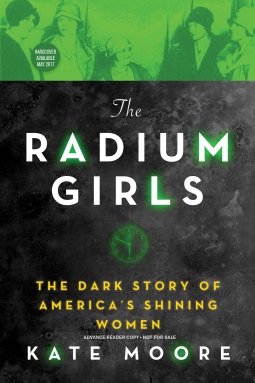I knew about the radium girls in the vaguest of senses thanks to an offhand mention in The Radioactive Boy Scout, a book I read a few years ago. Silverstein mentions that scores of workers (women, mostly) in the dial-painting factories became ill and even died from their work, but since that’s largely a footnote in the story of David Hahn, Silverstein doesn’t go into much detail about it. I didn’t think about it any further until last year, when I saw that an available book on NetGalley was Kate Moore’s The Radium Girls: The Dark Story of America’s Shining Women, adapted from and inspired by Melanie March’s play These Shining Lives.
Author: Kate Moore
My GoodReads rating: 5 stars
Average Goodreads rating: 4.35 stars
Language scaling: B2/C1+
Recommended audience: Readers interested in the early 20th century American labor movement, women’s history, or the history of radium and radioactivity.
Content warning: While it’s only brief parts of the book, Moore does not mince words to describe the effects of radium poisoning on the women in question.
In-depth thoughts: I wavered between 4 and 5 stars for this book. The story is harrowing and written well overall, but at some points all of the information becomes more overwhelming than anything else. Moore also has a tic of spending a lot of time on the physical description of almost everyone involved; as someone who relates strongly to descriptions of aphantasia, it’s not surprising that I would not find detailed descriptions of people’s appearances compelling. Other readers will no doubt appreciate Moore’s dedication to making these stories as real as possible. Finally, the Kindle version had some display and formatting errors, mostly based around the small-caps font used for the newspaper headlines and photos (there weren’t any).
In the end I decided on 5 stars because I think my issues were with the formatting rather than the content, and because I think everyone should read this book.
I have to admit, I was not entirely prepared for what I read. I know enough about radiation poisoning to know that the women employed in these factories suffered, and suffered a lot. That’s a biological reality I knew going in. It was how steadfastly the companies refused to acknowledge any wrongdoing that was the most shocking and the most viscerally upsetting. Their legal battles dragged on for years—over a decade. It’s one thing to lose an arm or the use of your legs and have a workman’s comp case take a few years. It’s another thing for the case to go on for 13 years when you’re dying of cancer.
The radium corporations insisted that the sick, dying, and dead women were already in poor health when they started work; they refused to release medical examination records; they insisted that the cause of death in a few cases was syphilis, not radium poisoning. They claimed in one case that radium was a poison and therefore not covered by existing workman’s compensation laws; after the law was changed to include poison, they turned around in another case and claimed that radium wasn’t poisonous at all.
People talking about #resisting in this weird new era we live in also talk about the importance of surrounding yourself with stories of people being courageous and doing the right thing. I think that makes The Radium Girls a book we should all be reading. It serves as both an inspiration and a warning.


